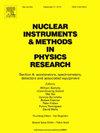Enhancement of CsPbBr3 detectors spectral performance for gamma-ray detection using simultaneous multi-waveform clustering method
IF 1.5
3区 物理与天体物理
Q3 INSTRUMENTS & INSTRUMENTATION
Nuclear Instruments & Methods in Physics Research Section A-accelerators Spectrometers Detectors and Associated Equipment
Pub Date : 2025-03-24
DOI:10.1016/j.nima.2025.170461
引用次数: 0
Abstract
As a room-temperature semiconductor detector, all-inorganic Proveskit CsPbBr3 (CPB) has great potential for gamma-ray detection and spectroscopy. However, most CPB samples suffer from spatially non-uniform responses, leading to variations in charge collection efficiency (CCE) for the identical deposited energy at different locations within the detector. This issue affects the apparent energy resolution of the detector. Therefore, the development of methods for correcting non-uniform CCE would be beneficial. In this paper, we have explored a simultaneous multi-waveform clustering method to classify different interaction patterns and derive the variation of CCE accordingly. This information is then used to correct the energy spectrum and enhance the energy resolution. Our results showed that by using this method, we can significantly improve the detector's energy resolution from 11.5 % at 122 keV to 4.4 % after the correction. The main advantage of our approach is that we can improve the spectral performance of a detector regardless of detector configuration and the sources of variations in CCE. Since the proposed method is based on waveform analysis, it could be effectively applied to other room-tempreature semiconductor detectors, such as CZTs.
同时多波形聚类方法增强CsPbBr3探测器的伽马射线探测光谱性能
作为一种室温半导体探测器,全无机Proveskit CsPbBr3 (CPB)在伽玛射线探测和光谱学方面具有很大的潜力。然而,大多数CPB样品受到空间非均匀响应的影响,导致探测器内不同位置相同沉积能量的电荷收集效率(CCE)发生变化。这个问题会影响探测器的视能量分辨率。因此,发展校正非均匀CCE的方法是有益的。在本文中,我们探索了一种同时多波形聚类方法来对不同的交互模式进行分类,并据此得出CCE的变化。然后利用这些信息校正能谱,提高能量分辨率。结果表明,利用该方法可以将探测器的能量分辨率从122 keV时的11.5%显著提高到校正后的4.4%。我们的方法的主要优点是,我们可以提高探测器的光谱性能,而不考虑探测器的配置和CCE变化的来源。由于该方法是基于波形分析的,因此可以有效地应用于其他室温半导体探测器,如czt。
本文章由计算机程序翻译,如有差异,请以英文原文为准。
求助全文
约1分钟内获得全文
求助全文
来源期刊
CiteScore
3.20
自引率
21.40%
发文量
787
审稿时长
1 months
期刊介绍:
Section A of Nuclear Instruments and Methods in Physics Research publishes papers on design, manufacturing and performance of scientific instruments with an emphasis on large scale facilities. This includes the development of particle accelerators, ion sources, beam transport systems and target arrangements as well as the use of secondary phenomena such as synchrotron radiation and free electron lasers. It also includes all types of instrumentation for the detection and spectrometry of radiations from high energy processes and nuclear decays, as well as instrumentation for experiments at nuclear reactors. Specialized electronics for nuclear and other types of spectrometry as well as computerization of measurements and control systems in this area also find their place in the A section.
Theoretical as well as experimental papers are accepted.

 求助内容:
求助内容: 应助结果提醒方式:
应助结果提醒方式:


